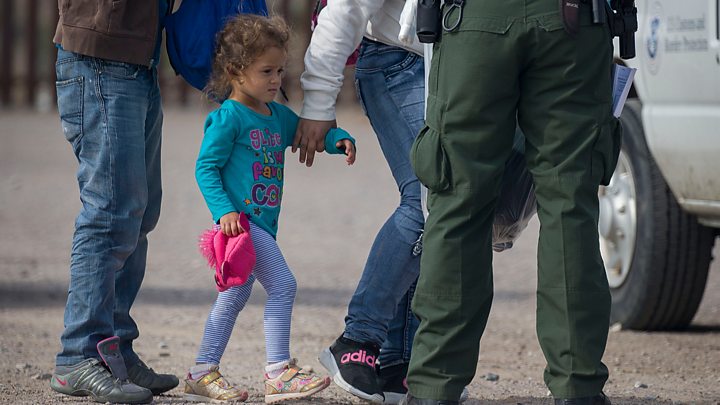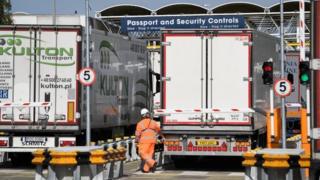 Image copyright
Image copyright
Reuters
The president in California – “Build the Wall” chants can still be heard at his rallies
Donald Trump’s proposed wall along the US-Mexico border helped take him to the White House, and with 2020 looming it is already a central part of his bid for re-election.
“The wall is being built. It’s going up rapidly,” the US president said last month.
His original pitch was a “big, beautiful wall” Mexico would pay for. The wall though is unlikely to be any of these. In fact it might not even be a wall.
But he has made much of progress – here is where his project stands now.
Little has actually been built…
On the ground, not much has changed. Since Mr Trump took power, US Customs and Borders Protection (CBP) says a total of 66 miles (106km) of “new border system” has been built.
Much of this is not new wall but rather improvement work on existing structures – there is already about 650 miles of barriers along the border.
The new system will be made of what the CBP describes as a combination of “steel-bollard barrier, all-weather roads, lighting, enforcement cameras and other related technology”.
The US-Mexico border spans 2,000 miles and although Mr Trump originally said his wall would span the entire distance, he has since clarified that natural features like mountains and rivers would help cover the rest.
There should be more to come though with construction planned in several border sites. The administration is aiming to have 509 miles of “new border wall system” ready by the end of 2020.
… but the pot is growing…
Although progress has been slow. President Trump can expect work to accelerate. That’s because the available funds have grown significantly since the early days of the administration.
His initial efforts were mired in legal and political difficulties. The start of the year saw the longest government shutdown in US history as Mr Trump refused to sign a budget unless it included money for the wall. He went on to declare a national emergency to free up funds.
Things got better for him – in July the Supreme Court gave the go-ahead for the US president to redirect $2.5bn (£2bn) of Pentagon funds for the wall. Then, in September a further $3.6bn in Pentagon funding was announced.
This and other funds bring the total available to $9.8bn. There may be more to come. US media report that the administration is considering diverting billions more in military funding.
… and immigration is ‘his issue’
The funds fall short even of Mr Trump’s initial price tag of up to $12bn, let alone the far higher estimates that include construction consultants and others.
But it is enough for the US president. If there was any doubt it is a signature policy of his, a trip to California this month saw him write his name on a stretch of the wall in thick black marker pen.
At his rallies “Build the Wall!” chants are still going strong.
It was a theme President Trump revisited again and again at one recently in New Mexico, a state comfortably won by Democrats in the past three elections but one he hopes to seize next time.
Image copyright
Getty Images
A campaign rally this year saw a supporter dress as a wall
Supporters there heard him tear into “open borders” Democrats, and say the wall is essential to keep Americans safe from drug smugglers. This argument has worked for him before politically and is one he’s likely to return to.
A book from two New York Times journalists suggests just how important President Trump regards immigration, and the extreme lengths he has considered to stop arrivals at the border – many of who are fleeing violence and poverty.
According to the book, he suggested shooting migrants in the legs, building an electrified, spiked border wall and a snake or alligator-infested moat.
Demanding the entire border be shutdown, the president is said to have told aides: “I ran on this. It’s my issue.” He has dismissed the book’s claims as “fake news”.
The funding has sparked a row
The latest $3.6bn batch of funding comes from the Pentagon, thereby diverting funds from scores of military projects.
Puerto Rico is a notable loser – the US territory, still recovering from a hurricane, misses out on $400m. Such projects are in effect on hold and need congressional approval to proceed.
Democrats, who have called the border wall a vanity project, attacked the move for steering money away from the military and for removing Congress’ power to approve spending.

Media playback is unsupported on your device
“It is a slap in the face to the members of the Armed Forces who serve our country that President Trump is willing to cannibalise already allocated military funding to boost his own ego and for a wall he promised Mexico would pay to build,” Senate Minority leader Chuck Schumer said.
As for Republicans, President Trump has found support even from legislators in vulnerable seats or those who will lose funding.
“We all have parochial concerns about our states but border security is part of national security so my constituents want to make sure we do our job,” Texas Senator John Cornyn told Politico.
Congress again tried to overturn Mr Trump’s emergency declaration in September. Expect arguments over funding to continue.
Mexico won’t be paying for the wall, but Estonia might
It is not just domestic military projects which will have funds diverted – schemes in 19 countries overseas will be hit too. This includes hundreds of millions intended to shore up European defences against Russia.
Announcing the move, US Defense Secretary Mark Esper suggested European countries should be funding the projects – President Trump has long complained that the US pays too much on security abroad.
Image copyright
Reuters
The president’s vision of what the wall will be has shifted since he took power
“The message that I’ve been carrying, since when I was acting secretary to today, has been about the increase in burden sharing,” Mr Esper said.
There is little suggestion now of Mexico directly paying for the wall. Even a host on the Trump-leaning Fox News said the president should “never should have said” Mexico would pay.
The administration, though, can point to a big drop in migrants arriving at the US border, after President Trump threatened to impose tariffs on Mexico if it did not launch a crackdown.
500+ miles by 2020 is looking ambitious
An uncooperative Congress is a major hurdle, and on the ground there are further challenges.
Environmentalists are suing over the construction, concerned that the new barriers could cause irreparable harm to sensitive habitats. Special powers allow the government to build in protected areas in favour of border structures.

Media playback is unsupported on your device
A government watchdog is also reviewing compulsory purchases being made along the US-Mexico border with property owners resisting the Trump administration’s efforts to build on private land.
Dr Victor Manjarrez Jr, a former border patrol chief who is now an academic at the University of Texas, is impressed with the administration’s efforts and says the administration’s target is achievable.
“But that being said though, even with the progress made, 500 miles… it’s going to be tough,” he said, citing the weather and logistical issues like having to make cement in remote areas of the border.
He also disputes that the wall alone can halt border crossings, for example pointing out that while walls are effective in urban areas they are less so in the desert.
Even if the wall were finished, he added, “you’ll see a reduction, you’ll see a shift in the flow, the demographics – the type of individuals coming across – will be different but the flow won’t stop. That is a problem of building false expectations.”
There’s logic to Trump’s approach
As a re-election strategy, is the US president on to something? It would appear so – although it is unlikely to win him new support. Polling suggests that in an already polarised political environment immigration is the thickest of wedge issues.
Thinktank Pew found this year that 82% of Republicans were in favour of the wall but for Democrats it was just 6% – the organisation’s Director of Political Research Carroll Doherty said it was “hard to see an issue that’s more partisan than that”.
Mr Doherty said there was an “intensity” felt about immigration by Republican voters Mr Trump will be targeting again.
“Will Trump be punished for not making more progress on the wall? That’s difficult to see because Trump has certainly identified Democrats as the obstacle to building the wall and he’s claimed progress on it,” he said.
“Support for the wall is still strong among Republicans and a lot of Republicans are still immigration voters.”












